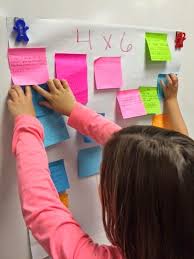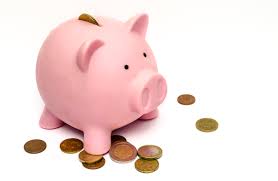Please find below information on our new math units. Please read over the appropriate grade level unit so you will know what your student is learning.

Third Grade:
Unit 9: This unit focuses on the important skills of multiplication and division. Using the area model for multiplication, students will develop an understanding of the partial products algorithm for multiplying and 1- digit and 2-digit numbers, as well as developing readiness skills for division. Students will also continue developing mental math strategies for multiplication.
Common Core Standards
Mathematics
Strand: 13.2 Number And Operations In Base Ten
Standard: 13.2.3 Geometric Measurement: Understand Concepts Of Area And Relate Area To Multiplication And To Addition.
CCSS – GLCE: 13.2.3.1 3.MD.5 Recognize area as an attribute of plane figures and understand concepts of area measurement.
Knowledge that area is the measure of total square units inside a region or how many square units it takes to cover a region. K
CCSS – GLCE: 13.2.3.2 3.MD.5.a A square with side length 1 unit, called “a unit square,” is said to have “one square unit” of area, and can be used to measure area.
Knowledge that a square with side length 1 unit, “called a unit square,” is said to have “one square unit” of area. K
CCSS – GLCE: 13.2.3.3 3.MD.5.b A plane figure which can be covered without gaps or overlaps by n unit squares is said to have an area of n square units.
Knowledge that the area of plane shapes can be measured in square units. K
CCSS – GLCE: 13.2.3.5 3.MD.7 Relate area to the operations of multiplication and addition.
Ability to explain the relationship of multiplication arrays and area. (3.OA.3) S
CCSS – GLCE: 13.2.3.6 3.MD.7.a Find the area of a rectangle with whole-number side lengths by tiling it, and show that the area is the same as would be found by multiplying the side lengths.
Ability to justify the understanding of area by comparing tiling and counting with repeated addition/multiplication. S
CCSS – GLCE: 13.2.3.8 3.MD.7.c Use tiling to show in a concrete case that the area of a rectangle with whole-number side lengths a and b + c is the sum of a × b and a × c. Use area models to represent the distributive property in mathematical reasoning.
Ability to construct rectangles on grid paper and decompose them by cutting them up or color coding them to investigate area. S
Ability to use a pictorial model of the distributive property to solve area word problems. S
Strand: 13.3 Number And Operations—Fractions5
Standard: 13.3.1 Use Place Value Understanding And Properties Of Operations To Perform Multi-Digit Arithmetic.4
CCSS – GLCE: 13.3.1.3 3.NBT.3 Multiply one-digit whole numbers by multiples of 10 in the range 10–90 (e.g., 9 × 80, 5 × 60) using strategies based on place value and properties of operations.
Ability to decompose numbers by 10s, 50s, and 100s starting at 1,000 S
Strand: 13.4 Operations And Algebraic Thinking
Standard: 13.4.1 Represent And Solve Problems Involving Multiplication And Division.
CCSS – GLCE: 13.4.1.3 3.OA.3 Use multiplication and division within 100 to solve word problems in situations involving equal groups, arrays, and measurement quantities, e.g., by using drawings and equations with a symbol for the unknown number to represent the problem.1
Ability to solve different types of multiplication and division word problems. S
Standard: 13.4.2 Understand Properties Of Multiplication And The Relationship Between Multiplication And Division.
CCSS – GLCE: 13.4.2.1 3.OA.5 Apply properties of operations as strategies to multiply and divide.2 Examples: If 6 × 4 = 24 is known, then 4 × 6 = 24 is also known. (Commutative property of multiplication.) 3 × 5 × 2 can be found by 3 × 5 = 15, then 15 × 2 = 30, or by 5 × 2 = 10, then 3 × 10 = 30. (Associative property of multiplication.) Knowing that 8 × 5 = 40 and 8 × 2 = 16, one can find 8 × 7 as 8 × (5 + 2) = (8 × 5) + (8 × 2) = 40 + 16 = 56. (Distributive property.)
Ability to apply the Properties of Operations as strategies for increased efficiency. S
Ability to break apart and manipulate the numbers (decomposing and composing numbers). S
Knowledge that the properties of division include the Distributive Property, but not Commutative or Associative. K
Standard: 13.4.3 Multiply And Divide Within 100.
CCSS – GLCE: 13.4.3.1 3.OA.7 Fluently multiply and divide within 100, using strategies such as the relationship between multiplication and division (e.g., knowing that 8 × 5 = 40, one knows 40 ÷ 5 = 8) or properties of operations. By the end of Grade 3, know from memory all products of two one-digit numbers.
Ability to model the various properties using concrete materials. S
Ability to use multiple strategies to enhance understanding. S
Knowledge of multiplication and division strategies and properties to achieve efficient recall of facts.
Fourth Grade:
Unit 9: This unit will focus on the link between fractions, decimals, and percent names for numbers. The unit will begin with practice converting among fractions and decimals. Students then use grid pictures for decimal and fractional names to reinforce the equivalence between them. Students will then estimate decimals and multiple these estimates to find reasonable solutions.
Common Core Standards
Mathematics
Strand: 14.3 Number And Operations—Fractions3
Standard: 14.3.3 Extend Understanding Of Fraction Equivalence And Ordering.
CCSS – GLCE: 14.3.3.1 4.NF.1 Explain why a fraction a/b is equivalent to a fraction (n × a)/(n × b) by using visual fraction models, with attention to how the number and size of the parts differ even though the two fractions themselves are the same size. Use this principle to recognize and generate equivalent fractions.
Knowledge of and ability to generate simple equivalent fractions. (3.NF.3b)
Standard: 14.3.5 Understand Decimal Notation For Fractions, And Compare Decimal Fractions.
CCSS – GLCE: 14.3.5.1 4.NF.5 Express a fraction with denominator 10 as an equivalent fraction with denominator 100, and use this technique to add two fractions with respective denominators 10 and 100.4 For example, express 3/10 as 30/100, and add 3/10 + 4/100 = 34/100.
Ability to show a fraction with a denominator of 10 as an equivalent fraction with a denominator of 100 in order to add the two fractions. S
CCSS – GLCE: 14.3.5.2 4.NF.6 Use decimal notation for fractions with denominators 10 or 100. For example, rewrite 0.62 as 62/100; describe a length as 0.62 meters; locate 0.62 on a number line diagram.
Ability to use decimal notation for fraction with 10 or 100 as the denominator.









